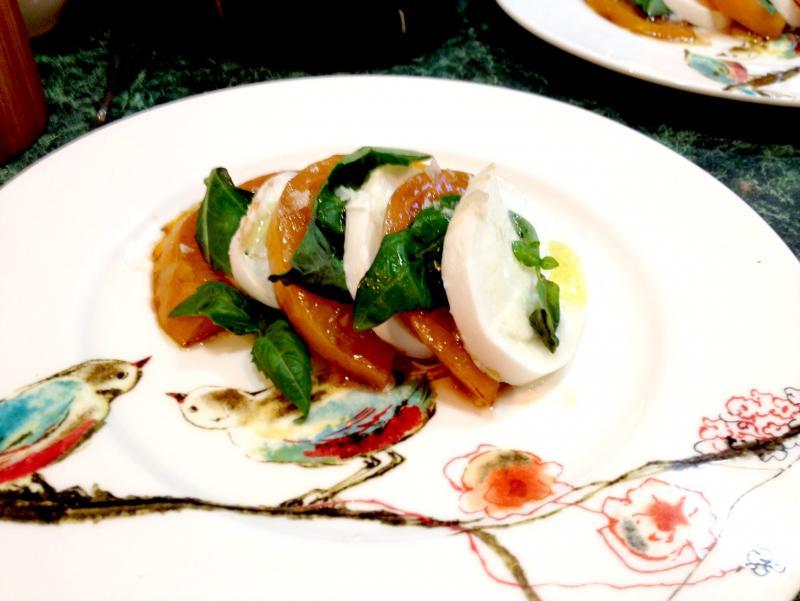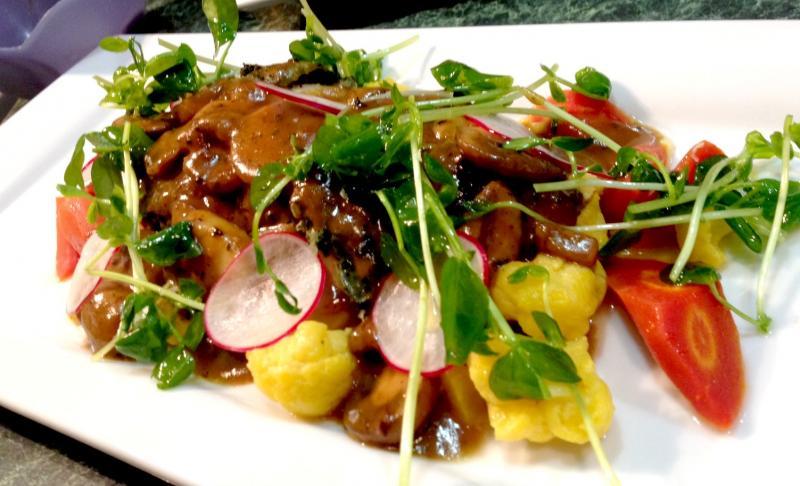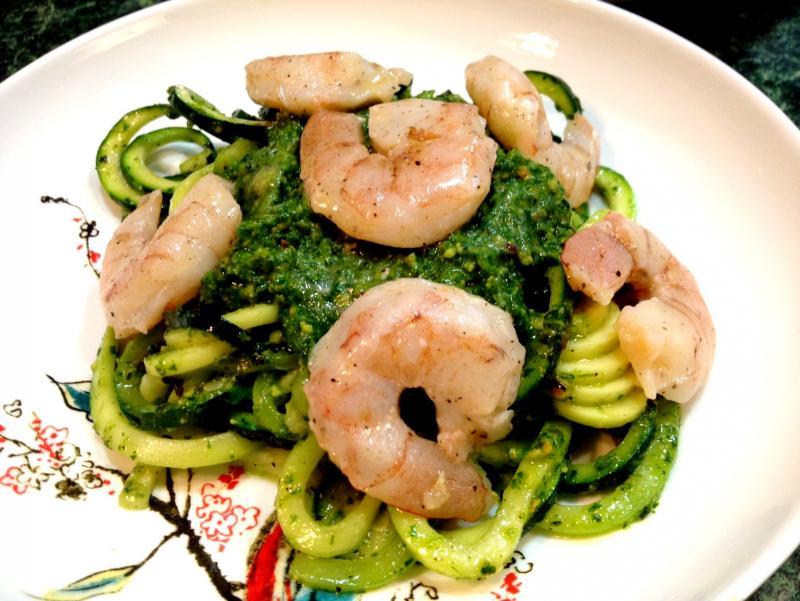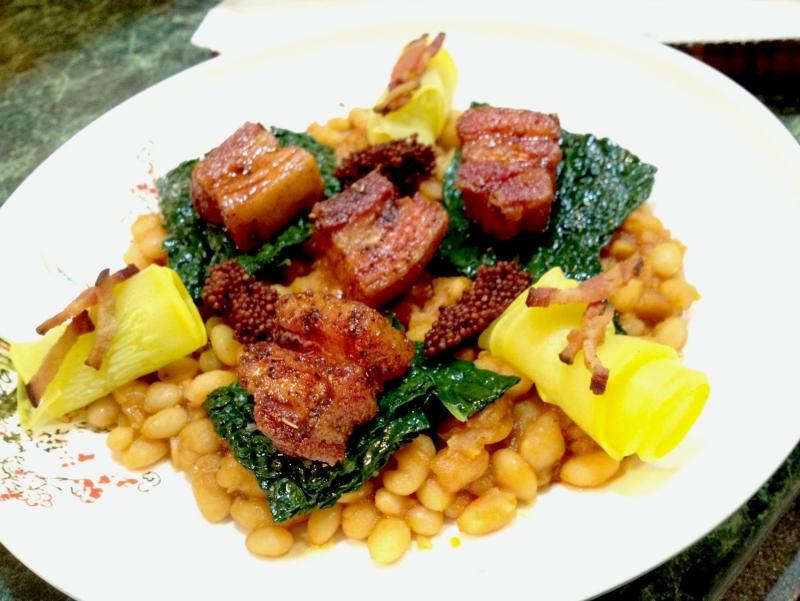-
Posts
1,807 -
Joined
-
Last visited
Content Type
Profiles
Forums
Store
Help Articles
Everything posted by btbyrd
-
Since it's already cooked just heat it to serving temp (like between 130 and 140F). That's what I do with duck confit. You may lose some crispiness reheating in the bag though.
-
Here's MC's technique for cryosearing and cryorendering duck. You're going to need a wire dog brush and some dry ice. But I digress.
-
" it tastes dry to me, not juicy and really soulless " I know what you mean, but I think a lot of it depends on what you're cooking. A sous vide burger or meatball or meat loaf will be super juicy. Same with sausages. Whole muscle cuts can vary widely. SV chicken breasts are not especially juicy in my experience, even when brined beforehand, and their uniform texture can be off putting. (It's great for chicken salad though!) That's not the case for pork chops or most cuts of beef. I've made some of the best fajita meat in of my life by cooking flank steak SV and then finishing it off on the grill; much more juice and flavor than I've had at any restaurant. "especially meat that could be cooked medium rare" One of the really great things about low temp cooking is that you CAN cook things medium rare that you otherwise couldn't. Low temp beef/pork cheeks are killer, as are short ribs. While I do like a traditional braise on these cuts, I much prefer the taste and texture of the SV version.
-
Like you, I've eaten a lot of great burgers cooked on grills and in pans. But I've also eaten a great burger that was cooked sous vide and then deep fried. The "extra work" (it's not really any more work than cooking in a pan, it just takes longer) was worth it because it produces a delicious result that you cannot achieve otherwise. It's not that this burger is inherently better than burgers prepared other ways, just that it has characteristics that the others lack (and vice versa). It's delicious in its own right. It's not a substitute for pan frying or grilling. It's its own thing. That's the point.
-
A couple tips to the OP: Don't pre-salt your meat when grinding or forming patties. If you do, you end up running the risk of having a sausage texture (which is nice on meatballs, but not so much for a burger). If you're not going to cook in Ziplocks, form your burgers and then par freeze them on a sheet pan lined with parchment or a silpat before vacuum packing. This will keep your burgers from getting squashed. Otherwise, use Ziplocks and the displacement method to seal. You don't need oil or butter in the bag. You may want to keep a torch handy to touch up the sides of the burgers if you're going to sear on a griddle. You can get a nice crust on the top and bottom, but the sides won't be as nice. That's a place where a deep or shallow fry has an advantage. Dave Arnold's preferred method seems to be a deep-fry pre-sear, into the bath, then a final sear on top of charcoal to refresh the crust and add flavor. Here's his take on the patty melt, as well as his "burger of the future", which both use this process.
-
A burger cooked sous vide and then deep fried is a thing of beauty. The idea that there's a perfect way to cook a burger is silly. There are many different ways to do it well, and you can produce excellent results with various techniques. Thick burgers cooked over a wood fire grill? Awesome. Thin patties seared on a plancha? Yes please. Stuffed with butter and cooked on a nice charcoal or gas grill? Mmhmm. Cooked by the fires of hell under a screaming hot broiler? Delicious. These will all deliver different results and what is better or worse is a matter of individual preference. I cook sous vide a lot. And by "a lot" I mean almost every protein I get my hands on (and I eat a lot of meat). I love the technique. But you know what? There are times when what I want - what I really want to eat - is a steak that has a thermal gradient and isn't uniform in color and doneness all the way through. The same is true with thicker burgers. Sometimes what I really want is a burger that goes from a nice char on the outside through medium/well and all the way down to rare in the center. Why? Because it's delicious, the texture is great, and it lets me experience the full spectrum of beef. Other times I don't want that. What's "perfect" depends on your preferences. I'd say the main advantage of a SV burger is consistency and precision. For inexperienced cooks/grillmasters, it can be difficult to tell when burgers are at the desired level of doneness. It's not easy to cook burgers for a large group of people who all have different desires. With SV, you can be sure that everyone's burger is cooked as they like it. Every. Single. Time.
-
I'd make a puree of avocado and full fat yogurt plus a bit of lemon or lime juice.
-
I usually use "light" olive oil when cooking or making mayonnaise. For deep frying I usually use canola or corn oil. I'd like to use lard or tallow more often, but it's expensive and harder to manage than vegetable oil.
-
The Ortiz anchovies are flippin' delicious. Expensive, but worth it if you're going to eat them whole (on a salad, pasta, or pizza).
-
If the alcohol is only used in a marinade and will not be used in a sauce, I don't think it's really necessary to worry about it since you'll be grilling the meat and that will destroy anything alcoholic on the surface of the meat. If you're really concerned about it, you could marinade the meat and then dry it off before grilling it and then baste with Yoshida sauce while it's finishing up. If that's not acceptable, I'd second Smithy's suggestion of using cola or beef stock (or both) in the marinade in the place of beer. And if that's not acceptable, I'd just use another recipe. There's more than one way to cook a tri-tip.
-
Herbed roasted chicken (breast) with mushroom gravy, rainbow carrots, cauliflower, radish, and pea tendrils. And from the other night, I did a capreze salad with vacuum marinated tomatoes: Served alongside shrimp with pistachio pesto (recipe from MC@H) over zucchini noodles. That pic was taken before I hit it with an obscene amount of parmigiano reggiano.
-
Yeah, because Blumenthal is known to just make things up. Snark aside, you can use your nose to test this out. It's pretty obvious when you smell a tomato versus smelling the plant/vine itself.
-
A sharp knife. I have a lot of kitchen gear and love a lot of it (especially my pressure cooker, circulator, and chamber vacuum) but since pretty much everything that is done in the kitchen depends on the ability to cut easily and cleanly, you can't get far without a nice, sharp chef's knife. For most tasks I use a Global G2 and keep it sharp with waterstones and a MAC ceramic hone.
-
I recently picked up a Matfer chinois and am very pleased with it. It's large and somewhat expensive, but the build quality is so high, and it's so sturdy when straining and pressing, that I'm sure it will last for decades in my kitchen.
-
Heston Blumenthal suggests that when making a tomato sauce, you should buy tomatoes on the vine and then add the vine to the sauce while simmering. He claims that the smell we associate with tomato plants (in a garden or greenhouse) comes primarily from the vine rather than the fruit, hence his suggestion. He doesn't mention leaves, however.
-
If you're thinking about spending that kind of money, check out the Waring Xtreme series of blenders. They're on a par with the Vitamix but are much cheaper.
-
It's tough because "salad" is ambiguous between the "primarily raw vegetables" sense and the "cold/room-temp items, including animal proteins, coated in a dressing" sense (e.g., tuna salad, egg salad, etc.).
-
36 hours at 70C. Thanks! The first time I ordered Bentons, I found it almost offensively salty when eaten on its own. I'm not sure if that batch was saltier than what I've gotten since, but I discovered that if I cook it so that it looks a little bit underdone (compared to where I would cook wet cured bacon) the result is much less salty. I'm not a big fan of floppy or limp bacon so I had been overcooking it to ensure crispiness. The results were salty shards of pork instead of delicious bacon. The texture can be deceptive when it's in the pan; once it's been drained and slightly cooled, the texture is much firmer/crisper than it looked like it would be. Once I tried deliberately undercooking it, everything came out perfectly. As for salt, I didn't add too much because I'd brined/cured the belly prior to cooking. Once I pulled it from the fryer I tossed it in a glaze of soy, mirin, honey, paprika, and aleppo chili flake. The soy added a bit of salt but I didn't use a heavy hand. I'm not the biggest fan of beans either, but the combination of belly/bacon and beans is delicious. It's "stick to your ribs" fare, and it was perfect for a chilly late-winter/early-spring evening. I doubt I'll be eating it in the middle of summer! Like you mention, I don't know of many classic southern dishes that use uncured belly... it's mostly just bacon, bacon, bacon. On menus I've come across a few dishes that use a sweet glaze on traditionally braised belly, but I don't see it very often. I don't know why this cut isn't more popular in the US, and in the south in particular. Many Asian cuisines celebrate this part of the pig, and rightly so. I must confess that the belly I used for this dish came from my freezer's "Pork belly for ramen" section. I love to pick up a slab of belly from the farmer's market, portion it, brine it, cook it sous vide, and freeze it in the bag. The quality doesn't really suffer from being frozen after cooking and then you've always got braised belly on hand.
-
Thanks! I wanted to do an upscale version of a classic southern dish... I wanted something that spoke to my southern roots but also used a lot of modern techniques. A lot of the components were prepared from recipes on the ChefSteps website. I did their sous vide navy beans but cooked them in demiglace instead of water and then combined them with onion, garlic, and tomato paste in the pan that was used to fry up the Benton's lardons. The mustard seeds were pickled using the ChefSteps recipe but I used black mustard seeds rather than yellow. I also cooked the kale sous vide (also from a ChefSteps) and used their guidelines for brining and cooking pork belly. I pickled the squash in a chamber vac with rice wine vinegar, mirin, and salt. Very good results! A very balanced dish. I totally plan on making it again.
-
The second ring doesn't indicate the maximum pressure possible in a KR; they'll go up to 1.2 bar before they start venting. The rings are just there to help you estimate the pressure you've achieved.
-
Pork and beans. Cured belly cooked SV for 48 hours, chilled, portioned, deep fried. With navy beans, kale, pickled squash, pickled mustard seeds, and Benton's lardons.
-
Theory is no substitute for practical experience. I can't imagine writing a book where I hadn't made each recipe at least twice. You can't cook a priori. I'm also unsure as to the target market of your book. If you, the author, has such great difficulty sourcing the ingredients that you can't even prepare the meals before writing the book... how can you expect your readers to be able to make the recipes? Sounds sort of like you're saying: "Season your dishes with unobtanium for taste and health!". Except you won't have any idea how the dishes will actually taste. And neither will your readers.
-

"Modernist Cuisine" by Myhrvold, Young & Bilet (Part 3)
btbyrd replied to a topic in Cookbooks & References
These books are huge and well made, filled with beautiful photographs and tons of information. Given that you can buy all six volumes for about the same (or even less) than dinner for two at a 3 star restaurant, I think it's well worth the money especially if you're a professional. The set costs less than my circulator did! Though the books have a lot of recipes, I mostly use MC as a reference work and resource for learning about novel (and traditional) cooking techniques. It's definitely not your standard cookbook. MC@H is more of a traditional cookbook in this regard, with step-by-step photos throughout and a focus on providing recipes (as well as a bit of science behind certain techniques). I don't own MC yet, but have read it through twice via my university library. I own MC@H and several other techy cookbooks (el Bulli, Alinea, Under Pressure) and would love to own the full version of MC. I haven't purchased it yet for purely budgetary reasons. MC@H is a fantastic book if you are just wanting to get your feet wet. There are lots of recipes, and lots of variations... I've gotten more out of MC@H than any other cookbook I own. I even see value in having MC@H in addition to the full blown MC given that the recipes in MC@H tend to focus on perfecting familiar dishes like chicken wings, mac and cheese, or pesto than on elaborate plated dishes. -
Measuring salt volumetrically is a bad idea. The same volume of different salts can differ by more than 200% in terms of weight. All salt contains essentially the same amount of sodium, so use whatever kind of salt you want. Just weigh it first.
-
Long cook times are fine below 140... I've done this plenty of times. It's always best to blanch things in boiling water for a short time before bagging to kill any nasties that might be on the outside. The inside of meat is pretty much sterile, so this should keep things clean for extended cooking. The Doug Baldwin reference cited above is a great resource if you're interested in low temperature pasteurization.






